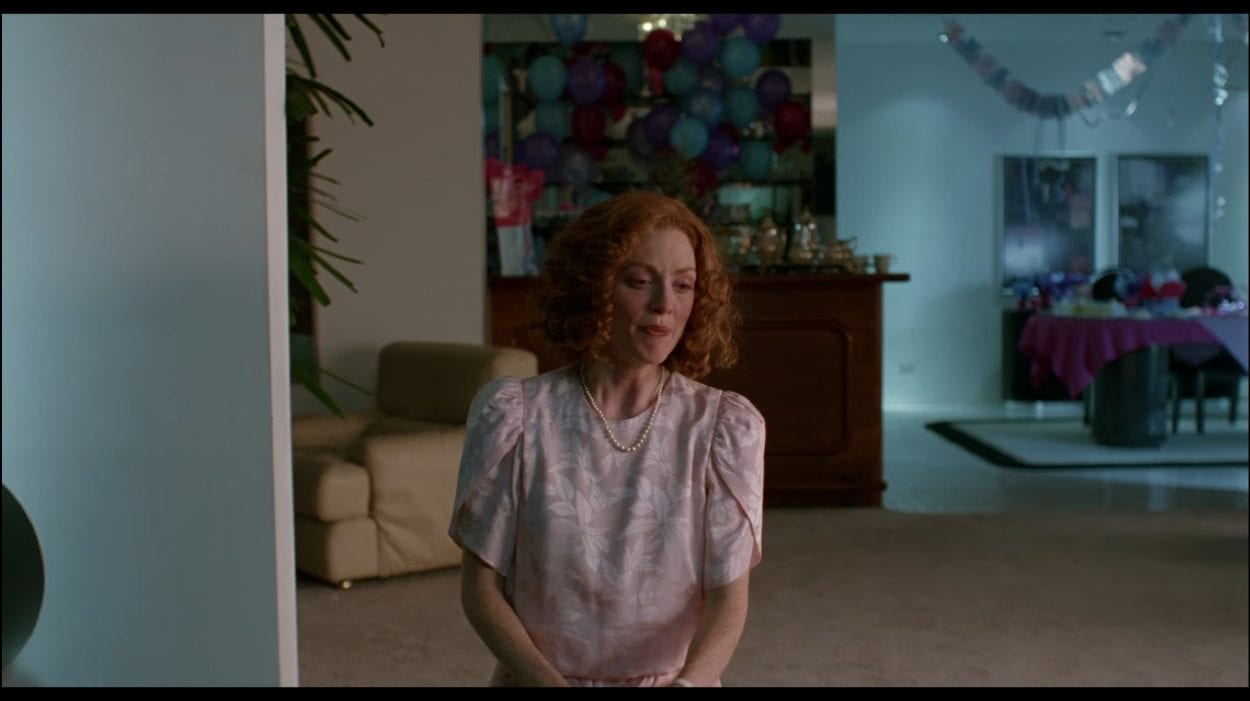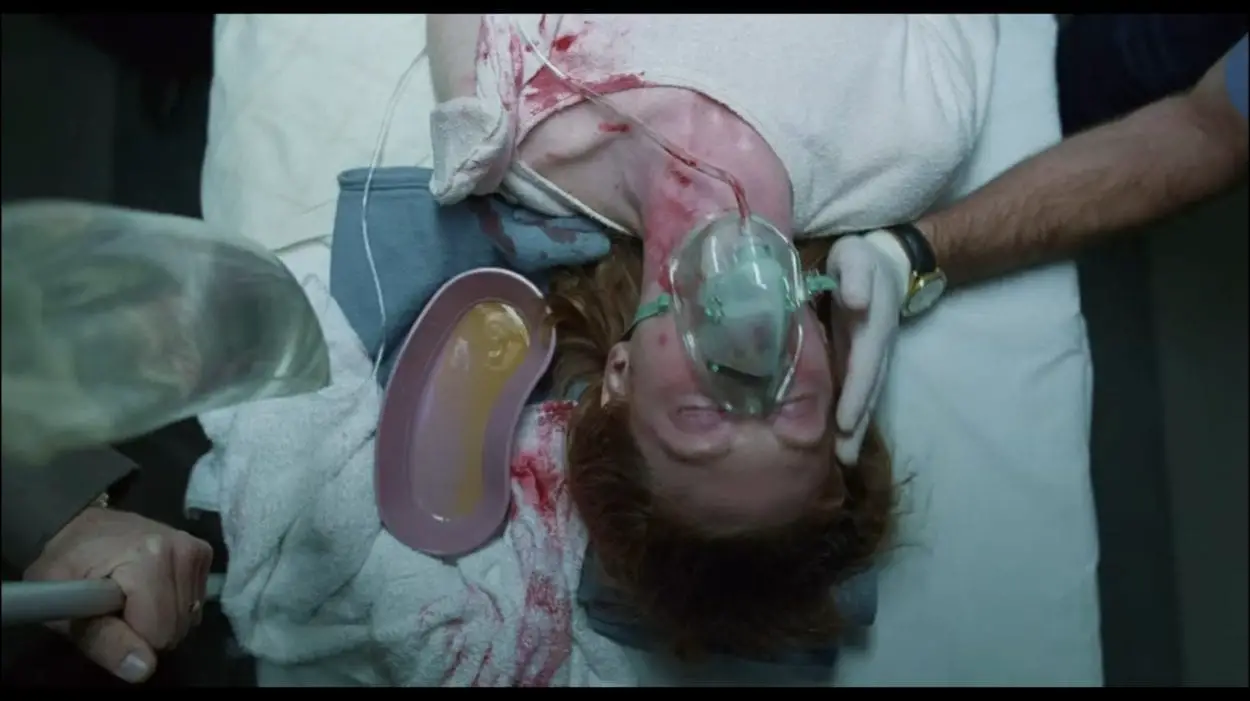America, 1987. The suburbs are the iconic locale of white middle-class U.S. families, compared to the failing social and economic conditions that face the minority populations of downtown urban environments like Los Angeles, New York, or Detroit. However, an invisible and much more terrifying force—environmental and chemical sickness—is starting to affect Americans of all ages, ethnicities, and social backgrounds within Todd Haynes’s 1995 social drama/thriller, Safe. With a dark and near-lifeless color palette, melancholy synth soundtrack, and lengthy uncut sequences focusing on the main character and her surroundings, Haynes places the audience in an atmosphere that brings a sense of dread as they’re forced to watch uncomfortable sequences of the main character’s isolation or physical sickness.
The beginning is an excellent tone-setter for the rest of the film, as the audience is placed in the driver’s seat of a car moving slowly through a streetlit, nighttime Los Angeles suburb. As the car reaches the garage of an expansive, modernist home, we get a sudden insert scene of main character Carol White (Julianne Moore) unenthusiastically having sex with her husband, Greg (Xander Berkeley). This lack of mutual affection between wife and husband is just one of the many visual signs of emotional emptiness that Carol experiences as part of her complacent, suburban living. Whether participating in aerobics classes, taking care of her home garden, or having brunches with friends, Carol seems to be living a comfortable if somewhat sterile life. These daily routines bring awareness to Carol’s seemingly robotic way of living that evokes a checklist more than living in the present. Furthermore, this soulless way of living parallels the increasingly regimented development of modern cities like Los Angeles, which is shown to harbor life-endangering characteristics of environmental tampering that affect Carol later in the film.
As Carol goes through these daily rituals, she starts to feel a slight sickness while sitting around painters working in her house, picking out furniture for the living room, or utilizing a new diet recommended to her by one of her friends. However, the major inciting incident that seems to kickstart Carol’s rapidly deteriorating health is when she drives behind a vehicle in downtown LA emitting a great amount of smog pollution from the muffler, causing her to have a violent coughing fit during which she pulls into a parking garage to try to breathe. This moment of the film highlights the anxiety of Carol’s situation, as Haynes utilizes a lengthy, unbroken shot of Carol following the offending vehicle. Haynes stays on her violent reaction to the smog to bring out a feeling of dread from the audience as she tries to get to safety while coughing nonstop.
After the harrowing physical reaction to the smog, Carol starts to complain to her husband about feeling ill, despite no obvious symptoms. Carol then goes to her doctor, who cannot provide any meaningful diagnosis to her feelings of sickness besides a mild allergic reaction and only offers a very general warning to give up her new diet. Following this scene, a frightful sequence occurs in which Carol begins to have an extreme panic attack while at a baby shower for one of her pregnant friends, causing her to need medical attention while surrounded by friends and acquaintances unable to help her. Haynes masterfully builds tension within the scene as Carol is shown interacting lightly with the friend group, going away to the bathroom, and coming back, but being completely silent until she starts to have her breakdown. Haynes allows the buildup to have an effective payoff, as the audience notices Carol worsening throughout the scene, while her friends do not. The breakdown is also much more effective because Carol is seated across the room from the entire friend group, allowing a strong sense of her detachment from her loved ones and friends.
After this distressing moment in the film, Carol starts to notice an ad at her aerobics class advertising a hearing about “environmental sickness” and decides to attend it without conferring with her husband and stepson beforehand. During the hearing, Carol and others in the audience watch a video that states that people are developing sicknesses from their environmental habitats, particularly the daily chemicals used in their environments within cleaning products, pesticides, and many other examples.

With all the concerns about environmentalism, pollution, and chemicals used in daily household products and foods today, this film, which was at the forefront of those discussions 25 years ago, has become much more relevant today. Even in 2019, Todd Haynes took the real-life controversies of chemicals used to produce nonstick pans, which caused real-world deformities and sickness, as the subject of his feature film Dark Waters (2019). The environmental concerns raised in Safe can be viewed as a precursor to that film in terms of how everyday products have the potential to harm everyone around the world. The modern debates around alternative medicine and lifestyles today are heavily prescient within this film, as Carol is forced to search for other methods to improve her health when modern medicine and health care cannot provide adequate aid to help treat her ailments. With all the modern knowledge of chemicals used in daily appliances like paint or food products and the warning labels that list a variety of dangerous possible side-effects for any generic commercial product, it seems now that Safe was prophetic in raising important discussions about how the general public should be informed about products.
When Carol starts to become warier of her environment and the chemicals consumed in both food and drink, she starts a heavily regimented diet, moves into a lined isolation room with an oxygen tank and masks, and wears simple clothing that isn’t chemically dyed or processed. After Carol unknowingly enters a drycleaning building in the process of being fumigated, she collapses and starts to have a violent seizure, then becomes paranoid around hospital workers spraying disinfectant nearby while she’s recovering. Haynes masterfully establishes the life-threatening nature that Carol now faces with her developed sickness; the brutally violent and physical reaction to the fumes is so sudden and alarming because it happens offscreen and is only shown when another character notices it. In addition, Haynes spares no detail in the dirtiness and bodily waste that suffering from this disease entails, as the mucus, vomit, and sweat coming from Carol’s body while being rushed into a hospital room is so visually nauseating and shown in such a lengthy manner that the audience begins to feel nearly as sick as Carol might during one of her episodes. With her husband and doctor unable to help her, Carol decides to go to an isolated ranch community that promotes chemical-free learning and living.
Separated from her husband and stepson, Carol becomes aware of the cult-like characteristics with its group-singing/repeated-mantra meetings and divided-gender living spaces. Just as Carol was seemingly lonely in her modern suburban lifestyle during the first half of the film, so she struggles to form meaningful connections in the ranching community. This is shown visually in her physical distance from most of the other inhabitants, as well as her choice to join groups that generate a mere surface-level sense of belonging. Haynes also utilizes wide shots of the barren, dirt landscape of the community to reveal that Carol is residing in an environment just as lifeless as the urban landscape of Los Angeles and her micromanaged house.
This then leads to a powerfully subtle conclusion where Carol enters her bunker on the ranch and looks into a mirror while constantly stating “I love you” until the film credits start to roll. The minimal decorations and lack of color in the bunker reveal that Carol is living in a place devoid of individual potential, forced to withdraw from any elements that might cause her harm—or differentiate her. And since other individuals might cause her sickness to flare dramatically, the mirror is utilized by both Haynes and Moore to show that Carol can only get a sense of affection by interacting with her own image.

The questions raised within the film about how the environment affects the health of today’s population is much more prevalent today, and while the film could’ve originally been analyzed as a reflection of the AIDS/HIV crisis of 1980s America, it has shifted to function as a broader warning of how self-isolation and societal withdrawal can be a crucial living style in the pandemic-facing world of 2020.


